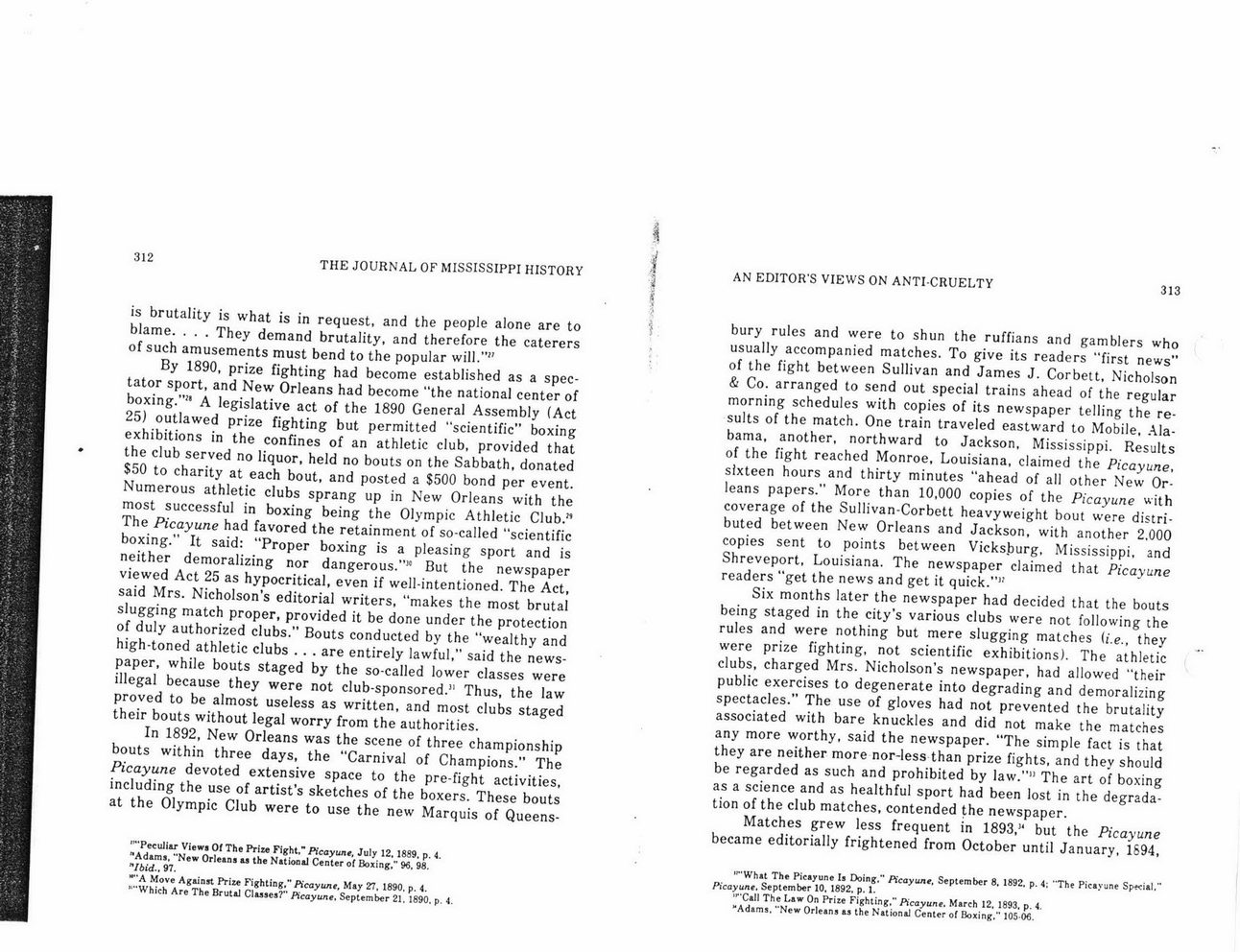This text was obtained via automated optical character recognition.
It has not been edited and may therefore contain several errors.
312
THE JOURNAL OF MISSISSIPPI HISTORY
is brutality is what is in request, and the people alone are to blame. . . . They demand brutality, and therefore the caterers of such amusements must bend to the popular will.?"
By 1890, prize fighting had become established as a spectator sport, and New Orleans had become ?the national center of boxing.?'* A legislative act of the 1890 General Assembly (Act 25) outlawed prize fighting but permitted ?scientific? boxing exhibitions in the confines of an athletic club, provided that the club served no liquor, held no bouts on the Sabbath, donated $50 to charity at each bout, and posted a $500 bond per event. Numerous athletic clubs sprang up in New Orleans with the most successful in boxing being the Olympic Athletic Club.? The Picayune had favored the retainment of so-called "scientific boxing.? It said: ?Proper boxing is a pleasing sport and is neither demoralizing nor dangerous.?10 But the newspaper viewed Act 25 as hypocritical, even if well-intentioned. The Act, said Mrs. Nicholson?s editorial writers, "makes the most brutal slugging match proper, provided it be done under the protection of duly authorized clubs.? Bouts conducted by the "wealthy and high-toned athletic clubs . . . are entirely lawful,? said the newspaper, while bouts staged by the so-called lower classes were illegal because they were not club-sponsored.11 Thus, the law proved to be almost useless as written, and most clubs staged their bouts without legal worry from the authorities.
In 1892, New Orleans was the scene of three championship bouts within three days, the "Carnival of Champions.? The Picayune devoted extensive space to the pre-fight activities, including the use of artist?s sketches of the boxers. These bouts at the Olympic Club were to use the new Marquis of Queens-
"?Peculiar Views Of The Prize Fight," Picayune, July 12, 1889, p. 4.
"Adams, ?New Orleans as the National Center of Boxing," 96, 98.
"Ibid., 97.
*?A Move Against Prize Fighting," Picayune, May 27. 1890, p. 4.
??"Which Are The Brutal Classes?" Picayune, September 21, 1890, p. 4.
AN EDITOR'S VIEWS ON ANTI-CRUELTY
313
bury rules and were to shun the ruffians and gamblers who usually accompanied matches. To give its readers ?first news? of the fight between Sullivan and James J. Corbett, Nicholson & Co. arranged to send out special trains ahead of the regular morning schedules with copies of its newspaper telling the results of the match. One train traveled eastward to Mobile, Alabama, another, northward to Jackson, Mississippi. Results of the fight reached Monroe, Louisiana, claimed the Picayune, sixteen hours and thirty minutes ?ahead of all other New Orleans papers." More than 10,000 copies of the Picayune with coverage of the Sullivan-Corbett heavyweight bout were distributed between New Orleans and Jackson, with another 2,000 copies sent to points between Vicksburg, Mississippi, and Shreveport, Louisiana. The newspaper claimed that Picayune readers ?get the news and get it quick.??
Six months later the newspaper had decided that the bouts being staged in the city?s various clubs were not following the rules and were nothing but mere slugging matches {i.e., they were prize fighting, not scientific exhibitions). The athletic clubs, charged Mrs. Nicholson?s newspaper, had allowed ?their public exercises to degenerate into degrading and demoralizing spectacles." The use of gloves had not prevented the brutality associated with bare knuckles and did not make the matches any more worthy, said the newspaper. ?The simple fact is that they are neither more nor-less than prize fights, and they should be regarded as such and prohibited by law.?? The art of boxing as a science and as healthful sport had been lost in the degradation of the club matches, contended the newspaper.
Matches grew less frequent in 1893,? but the Picayune became editorially frightened from October until January, 1&94,
"?What The Picayune Is Doing," Picayune, September 8, 1892, p. 4; "The Picayune Special." Picayune, September 10, 1892, p. 1.
??Call The Law On Prize Fighting," Picayune, March 12, 1893, p. 4.
?Adams. ?New Orleans as the National Center of Boxing," 105 06.

Pearl Rivers Journal of Mississippi History Vol. XXXIX No. 4 November 77 - An Editor's Views on Anti-Cruelty Eliza Jane Nicholson of the Picayune -6